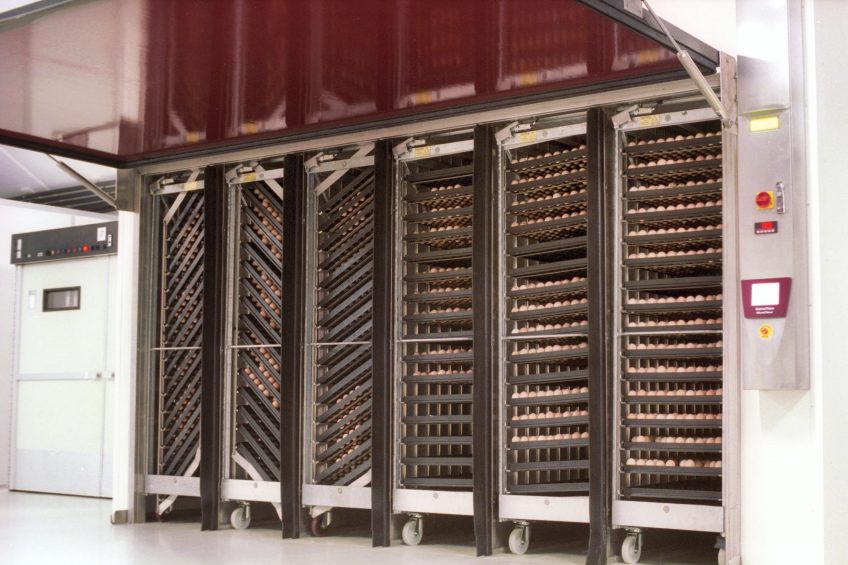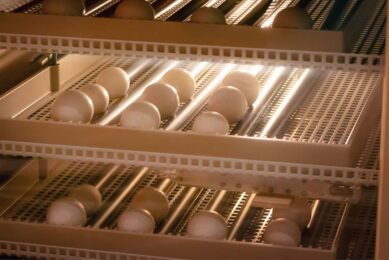Prevent malposition by focussing on turning angle and frequency

Four main aspects of turning hatching eggs have been identified as being integral to the ultimate success of incubation; turning during storage, critical periods for turning during incubation, turning frequency during incubation and turning angle during incubation. This fourth and last article in a series will focus on the the effect of turning angle and frequency during incubation to prevent malposition of the chick in the egg.
In recent years there has been some indication that the number of malpositioned (head in small end of eggs) embryos has increased. The reason has been unclear but the greater metabolic rates and increased broiler yield potential of modern strains has raised the question as to whether normally accepted incubation practices remain optimal. The common head in small end of egg malposition of chick embryos has been suggested to be due to egg orientation (e.g., set upside down), “air hunger”, lack of turning during the first week of incubation, older breeder flock age, and improper turning angle.
Theoretically, to achieve optimum hatchability, eggs should be turned at an angle of 45o from vertical but commercial incubators often exhibit turning angles of less than 45o. To determine the proper turning angle the typical angle of 45o was compared to 40o and 35o angles while turning the eggs 24 times daily (Figure 1). The incidence of malposition II embryos was significantly increased and fertile hatchability of eggs from older broiler breeder flocks was numerically decreased by the 35o angle compared with the 40 and 45o angles (Figure 1).
Figure 1 – The effect of turning angle with hourly turning on fertile hatchability, early dead embryos (E0-E7), late dead embryos (E18-E21+pipped) and malposition II embryos with the 55 and 57-week-old flocks in the two trials of Experiment 1 (Adapted from Elibol and Brake, 2006c).

It was reasoned that a reduced turning angle might be compensated for by an increased turning frequency so that the total distance travelled during turning was similar. In another experiment it was found that malposition II was significantly decreased and fertile hatchability was improved at a turning angle of 35o when the turning frequency was increased from 24 times daily (24X) to 96 times daily (96X) (Figure 2). This proved that it was the total turning distance each day rather than specific turning angle that was the critical factor.
In the present experiments the incidence of malposition II embryos was increased by a reduced turning angle in eggs from older broiler breeder flocks and then corrected by a concomitant increase in turning frequency. The data of our study suggested that a combination of reduced turning angle and increased turning frequency, rather than the classic hourly turning at 45°, could meet the requirements for early positioning of the chicken embryo. Additionally, these data demonstrated the possibility to commercially utilise a reduced turning angle during incubation to increase the distance between trays and improve air flow. This might be especially important for larger eggs in commercial machines or to provide the opportunity to increase incubator capacity and reduce incubation cost per chick if the turning frequency was concomitantly increased.
Figure 2 – The effect of turning angle and daily turning frequency on fertile hatchability, early dead embryos (E0-E7), late dead embryos (E18-E21+pipped) and malpositioned II embryos with the 57 and 61-week-old flocks in the two trials of Experiment 2 (Adapted from Elibol and Brake, 2006c).

Finally, a turning angle of less than 40°C may often be encountered in commercial incubators. The present data show that such small deviations could decrease hatchability (Figures 1 and 2). A simple angle or frequency adjustment could reduce the incidence of malposition II embryos and improve hatchability.
References available upon request.
Join 31,000+ subscribers
Subscribe to our newsletter to stay updated about all the need-to-know content in the poultry sector, three times a week. Beheer
Beheer








 WP Admin
WP Admin  Bewerk bericht
Bewerk bericht